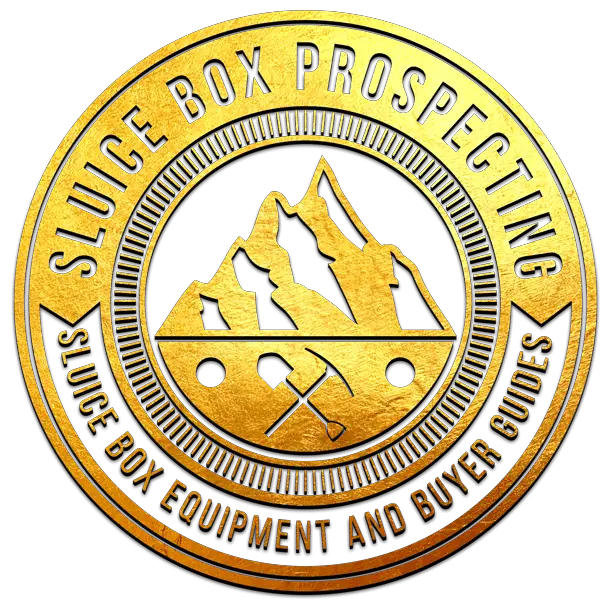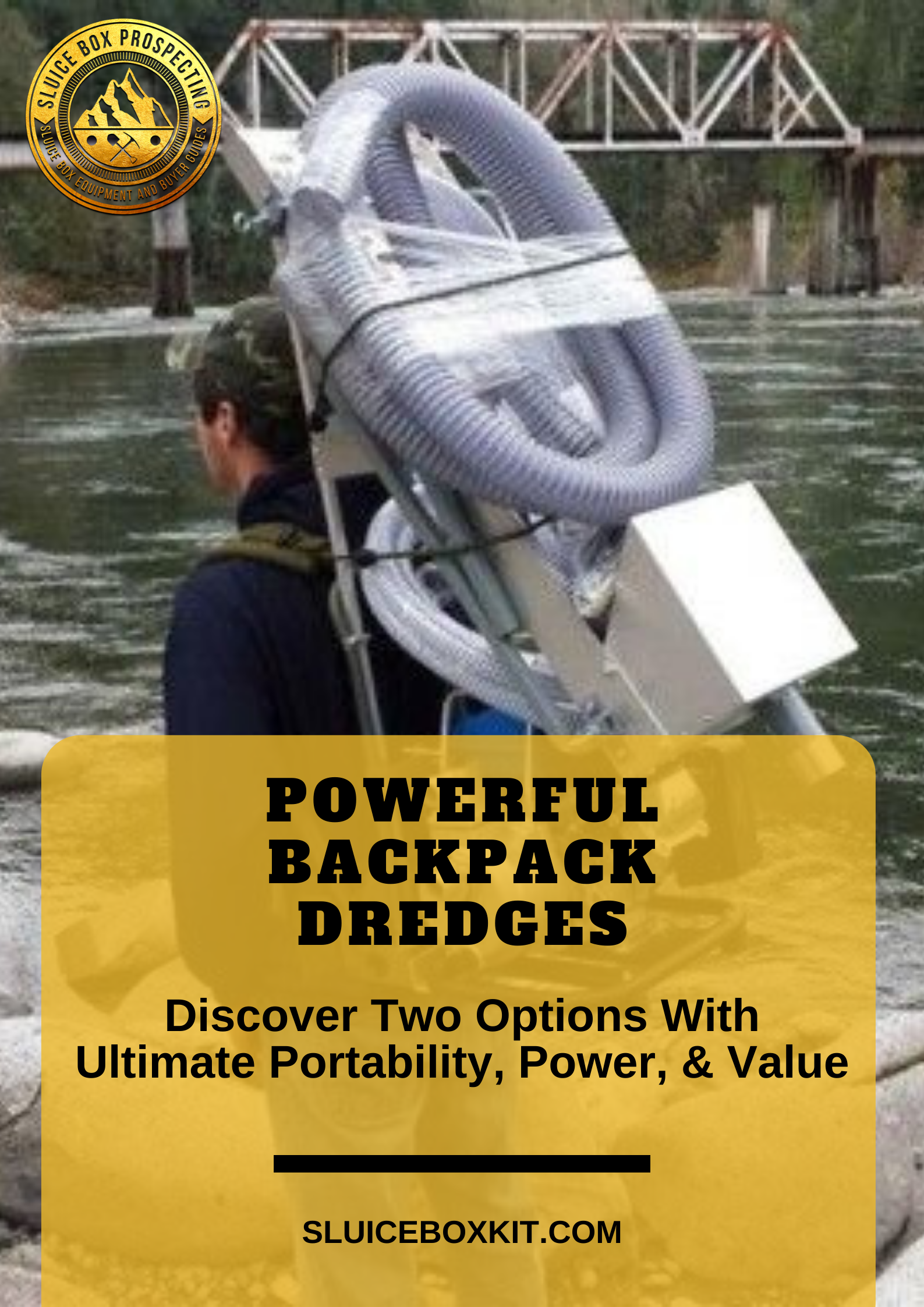Did you know that you don’t even have to purchase an expensive claim to mine for gold? A backpack dredge gives users access to gold-bearing streams on public lands, which there are many in the US and Canada. Learn more about backpack dredges below.
Backpack dredges contain all the equipment necessary to dredge for gold in streams, ponds, and lakes. Some of these are equipped with suction hoses, while others have power jets. These typically weigh 50-75 pounds, making them easy to carry over rough terrain.
Keep reading to learn more about the benefits of backpack dredges, how to shop for one, and tips for finding the equipment that will best suit your gold prospecting needs.
What Is A Backpack Dredge?
A backpack dredge is a portable dredging system that contains a sluice box, riffles or carpet, a pump, and the necessary hose and fittings.
A backpack dredging system is an affordable way to sluice gold in remote locations. As a self-contained unit that is transportable by backpack, prospectors can carry their equipment for extracting gold from riverbeds in one trip.
A backpack gold dredge is a budget-friendly way to experience the benefits of using dredging without heavy-duty, expensive machinery.
4 Components Of A Backback Dredge:
- Portable Sluice Box: An aluminum sluice short enough to carry by backpack.
- Riffles and carpet: Riffles and carpeting are essential to collecting gold particles.
- Pump: Many backpack dredges come with a small pump, such as a 90 GPM 2.5 HP engine. You can carry the pump by hand or configure it with the backpack.
- Hoses and fittings: All the necessary hoses and fittings can mount on the backpack.
How does the dredge float?
A backpack dredge comes with a hollow flotation platform. This device allows the dredge to float on water when in use.
What Can You Do With A Backpack Dredge?
Prospectors can quickly process large amounts of dirt, sand, and gravel from river bottoms to find valuable gold deposits and treasures with a backpack dredge. With a nozzle to place in riverbeds or other crevices underwater, high-powered pumps create suction and pump the sediment into the sluice.
Both the US and Canada are blessed with extensive public lands, many of which are home to gold-bearing streams. You can usually access these streams, just so long as you do not trespass private land to get there.
Using a metal detector to locate gold or other mineral deposits is an allowed activity under the General Mining Laws and is subject to the 36 CFR 228A regulations. – usda.gov
Some states may require permits or have more restrictive rules.
The use of vacuum or suction dredge equipment, otherwise known as suction dredging, is currently prohibited and unlawful throughout California. – Suction Dredge Permits
Always check your state and local laws to ensure that you are hunting a prospecting safely and lawfully.
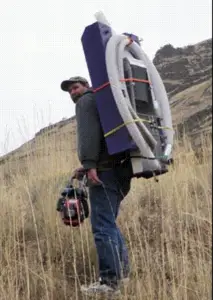
source: Gold Fever Prospecting
Almost anyone can navigate to gold-bearing locations and start prospecting for gold. The biggest obstacle is that you’ll most likely have to go off the beaten path to get there. For helpful tips on finding gold in creeks, check out the post, How To Pan For Gold In Creeks.
Is Dredging For Gold Profitable?
Since 2000, gold prices have skyrocketed, currently sitting at $1,831.80 per ounce. Dredging for gold can be profitable with a bit of experience and suitable locations.
The U.S. Forest Service has put together an excellent publication on mining for gold in Alaska. At the time of publication (the early 2000s), the tiniest flakes of gold could deliver a few cents apiece. What’s true in Alaska is also true in much of the lower 48 in places where such opportunity arises.
What Are The Advantages Of A Backpack Dredge?
Using a backpack dredge can benefit the average prospector or smaller outfits who do not need or want the hassle and expense of more extensive equipment. The advantages of backpack gold dredge are its portability, affordability, effectiveness, and low maintenance qualities.
Portability
Backpack dredges contain light materials and typically weigh 50-100 lbs. The weight of a typical kit means that anyone can take these dredges into remote locations to prospect for gold.
You can easily walk up to promising areas up in the mountains without taking a road. It’s also good for prospecting on land that you are contemplating leading or purchasing for gold prospecting.
Affordability: How Much Does A Backpack Dredge Cost?
Depending on the equipment setup, backpack dredges can cost between $1,500 to $3,500 . Keene Engineering makes two of the most popular and dependable all-encompassing sets.
The larger the dredge, the larger the output. Dredges the size of boats can cost upwards of $50,000. Full-sized industrial operations cost millions.
Easy To Maintain
Backpack dredges are not very complicated. You don’t have to be too handy to troubleshoot problems, and the parts are easy to repair or replace. You have a small sluice box, two floats, hoses, and a pumping system.
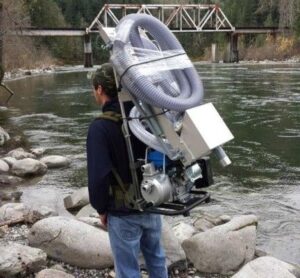
2 Dependable Backpack Dredge Options
In the section below, you’ll find detailed specs concerning the differences between different dredges. Also included are tips on which prospecting equipment to buy.
Power Jet vs. Suction Nozzle: What’s the Difference?
When you start looking for backpack dredges, you’ll notice that some provide power jets while others have suction nozzles. The table below lists the differences between the two and the advantages/disadvantages of each.
| Power Jet | Suction Nozzle | |
| Parts | One hose (or shorter pressure hose) | Two hoses |
| How It Works | Material gathers through a single hose | A vacuum is created between two hoses in which gravel and water then push through the hose. |
| Advantages | A single hose is easier to handle than two hoses, plus the material can be lifted higher than what a suction nozzle can do. | Effective in shallow water, sluice will work even if the suction hose is out of the water. |
| Disadvantages | Must be kept underwater at all times. Not practical for working in shallow water. | It is not practical for floating dredges over deeper water, which effectively power jets anyway since they use a compressor. |
Who Makes The Best Backpack Dredges?
Keene Engineering manufactures an affordable lineup of dredges, including backpack dredges and larger dredges that are still small enough to fit in the bed of a pickup truck. Below you’ll find more info on their two backpack models.
Keene 2″ Backpack Dredge With Power Jet
- Price: $2,495
- Pump Gallons per Minute (GPM): 100
- Sluice Box Size: 10′ x 36″
- Dredge Capacity: 1.5 yards per hour
- Net weight: 65 lbs.
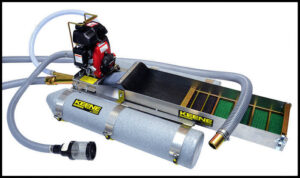
The Keene 2″ Backpack Dredge With Power Jet is a solid choice for running through sand and gravel in streams and ponds. The unit comes with 15 feet of suction hose and a 4-foot pressure hose. A heavy-duty Honda GX50 engine powers the pump.
2″ Backpack Dredge With Suction Hose
- Price: $2,450
- Pump Gallons per Minute (GPM): 100
- Sluice Box Size: 10″ x 36″
- Dredge Capacity: 1.5 yards per hour
- Net weight: 66 lbs.
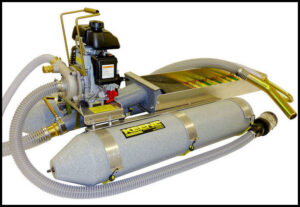
The Keene 2′ Backpack Dredge With Suction Hose is the best option if you anticipate doing much of your prospecting in shallow waters. The unit comes with 15 feet of suction hose and 17 feet of the pressure hose.
What Equipment Do I Need For Dredging?
You’ll definitely need a gold pan for cleaning out your dredge sluice box, for starters. It would also be helpful to equip yourself with some handy digging tools for working through rock jams. Below are some quality equipment options.
- Gold pan: Top 5 Best Gold Pans
- For screening fine material (such as sand from the sluice): Gold Cube 3 Stack
Final Thoughts
Backpack dredges allow prospectors to reach remote locations with ease. They contain flotation devices to make them easy to use in small streams and ponds. For shallower water, you’ll want to go with a suction hose. Power jets are most effective in deep waters and for working through gravel.
